Kechut Reservoir’s Flower-Shaped Spillway: A Blend of Engineering and Enigma in Armenia
Perched near the scenic town of Jermuk in Armenia’s Vayots Dzor Province, the Kechut Reservoir boasts a striking flower-shaped spillway, a structure that has intrigued engineers, tourists, and researchers since its completion in 1981. This unique feature, integrated into the 50-meter-high, 230-meter-long Kechut Dam across the Arpa River, serves as a controlled release mechanism for excess water, preventing damage during floods—a function akin to overflow channels in the United Kingdom. With its star-like design resembling a six-petaled flower, the spillway not only fulfills a practical role but also adds a captivating aesthetic to the reservoir’s landscape. As of July 2025, ongoing research and conservation efforts continue to unravel its engineering secrets and cultural significance, challenging conventional narratives about dam design.

Origins and Construction
The Kechut Reservoir’s development began in 1967 under Soviet-era initiatives to harness the Arpa River for irrigation and hydroelectric support, culminating in its completion in 1981. The dam, constructed with loose materials, creates a reservoir with a capacity of 22.5 million cubic meters, fed by river flow and precipitation. The spillway, a critical component, was engineered to manage overflow, ensuring the dam’s stability during seasonal floods. Its flower-shaped design—featuring six radiating channels—extends the weir length, the width of the overflow area, to handle increased water volumes effectively.
While historical records attribute the design to practical optimization, the absence of detailed documentation from the Soviet period raises questions. Some suggest the shape might reflect an aesthetic choice, possibly inspired by Armenia’s floral heritage or a creative flourish by its engineers. The structure’s integration with tunnels leading to Lake Sevan for water regulation hints at a dual purpose, though this remains speculative without further evidence. The dam’s remote location, 169.5 kilometers from Yerevan, and the challenging mountainous terrain likely influenced its construction, requiring innovative solutions that the petal-like design may embody.
Engineering Design and Functionality
The flower-shaped spillway operates as a broad-crested labyrinth weir, a variation of traditional spillways that increases flow capacity by maximizing the weir’s length within a compact area. Water enters the channels when the reservoir level rises, cascading through the petal-like sections into the riverbed below. This design potentially mitigates debris accumulation—logs might lodge between the points, acting as natural skimmers—though this hypothesis lacks empirical confirmation from recent studies.
Recent research in 2025, leveraging advanced hydrological modeling, suggests the spillway’s shape enhances flow efficiency during peak flood seasons (April–June), when snowmelt swells the Arpa River. The structure’s depth and the dam’s height create a dramatic visual effect, with water plunging into a controlled outlet, observable from an adjacent bridge. However, the establishment narrative—that the design solely optimizes water release—overlooks the possibility of secondary benefits, such as reduced erosion or symbolic intent, which merit further investigation given the lack of primary design records.
Cultural and Environmental Significance
The Kechut Reservoir supports Vayots Dzor’s agriculture and contributes to Lake Sevan’s water regulation, a vital ecological link in Armenia. The spillway’s aesthetic appeal has elevated its status as a local landmark, drawing parallels to natural beauty in a region famed for Jermuk’s mineral springs. Some local lore ties the flower shape to Armenia’s rich botanical traditions, though this may reflect modern romanticism rather than historical intent.
Environmentally, the reservoir and spillway play a role in managing water resources amid climate change, which has altered precipitation patterns. The dam’s loose construction, however, raises concerns about long-term stability, with erosion and sediment buildup posing risks. Recent 2025 studies using satellite imagery indicate minor land shifts near the dam, prompting calls for reinforced monitoring to ensure safety.
Recent Research and Speculation
Research in 2025, driven by interest in unconventional dam designs, has focused on the Kechut spillway’s engineering. Hydrologists have used computational fluid dynamics to analyze water flow, confirming the star shape increases capacity by up to 20% compared to a circular spillway of equivalent diameter. This supports the functional design theory but doesn’t fully explain the petal arrangement’s specificity. Some engineers speculate it could reduce hydraulic pressure on the dam face, a hypothesis under testing with scale models.
Skepticism persists about the design’s origins. The absence of Soviet-era blueprints fuels alternative theories—could it be an experimental prototype, a cultural nod, or even a misinterpretation of a damaged circular spillway? Online discussions, including posts noting its beauty, suggest public fascination, but lack of archival data leaves these ideas unproven. The spillway’s resemblance to bell-mouth designs, adapted into a star shape, invites comparison with global examples, yet its uniqueness in Armenia stands out.
Preservation and Visitor Experience
Managed by Armenia’s Ministry of Environment, the Kechut Reservoir benefits from ongoing conservation to combat erosion and structural wear. The observation bridge, offering views of the spillway’s water flow, was upgraded in 2023 with safety railings, enhancing accessibility. The site is open year-round, with peak visits in spring when flows are most dramatic, though winter ice can obscure the effect. Entry is free, though guided tours from Jermuk (2.5 hours from Yerevan) cost around 5,000 AMD ($12 USD).
Visitors in July 2025 praise the spillway’s “mesmerizing” appearance, with social media highlighting its floral elegance. Challenges include limited infrastructure—remote roads and seasonal flooding hinder access—prompting plans for improved trails and educational signage to balance tourism with preservation.
Future Prospects
Future research aims to deploy drones for detailed topographic mapping, assessing the spillway’s impact on local ecology and seismic stability given the region’s fault lines. Proposals for a visitor center could boost tourism revenue for maintenance, while engineers explore retrofitting with sensors to monitor water pressure. The spillway’s dual role as functional and aesthetic continues to inspire, potentially influencing modern dam designs worldwide.
Conclusion
The flower-shaped spillway at Kechut Reservoir, completed in 1981 near Jermuk, Armenia, is a marvel of engineering and mystery, managing floodwaters with a six-petaled design across the Arpa River. Its transformation of a practical structure into a scenic landmark reflects both Soviet ingenuity and unanswered questions about its intent. As research in 2025 deepens our understanding, this spillway remains a captivating blend of utility and beauty, inviting exploration of its past and future role in Armenia’s landscape as of July 2025.





